《管理学》课程PPT教学课件(Management, 7th Edition)Chapter 14 FOUNDATIONS OF BEHAVIOR
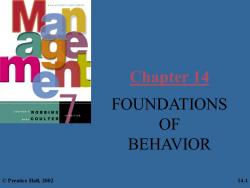
Chapter 14 FOUNDATIONS DROB BI NS ACOULTER OF BEHAVIOR ©Prentice Hall,2002 14-1
Chapter 14 FOUNDATIONS OF BEHAVIOR © Prentice Hall, 2002 14-1

Learning Objectives You should learn to: Define the focus and goals of organizational behavior Describe the three components of an attitude -Identify the role that consistency plays in attitudes Explain the relationship between satisfaction and productivity Tell how managers can use the Myers-Briggs personality type framework and the big-five model of personality ©Prentice Hall,2002 14-2
Learning Objectives You should learn to: – Define the focus and goals of organizational behavior – Describe the three components of an attitude – Identify the role that consistency plays in attitudes – Explain the relationship between satisfaction and productivity – Tell how managers can use the Myers-Briggs personality type framework and the big-five model of personality © Prentice Hall, 2002 14-2
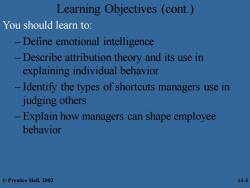
Learning Objectives (cont. You should learn to: Define emotional intelligence Describe attribution theory and its use in explaining individual behavior Identify the types of shortcuts managers use in judging others Explain how managers can shape employee behavior ©Prentice Hall,2002 14-3
Learning Objectives (cont.) You should learn to: – Define emotional intelligence – Describe attribution theory and its use in explaining individual behavior – Identify the types of shortcuts managers use in judging others – Explain how managers can shape employee behavior © Prentice Hall, 2002 14-3
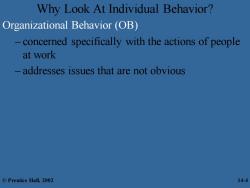
Why Look At Individual Behavior? Organizational Behavior (OB) -concerned specifically with the actions of people at work addresses issues that are not obvious ©Prentice Hall,2002 14-4
Why Look At Individual Behavior? Organizational Behavior (OB) – concerned specifically with the actions of people at work – addresses issues that are not obvious © Prentice Hall, 2002 14-4
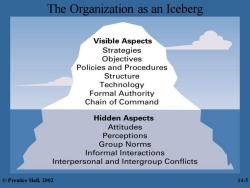
The Organization as an Iceberg Visible Aspects Strategies Objectives Policies and Procedures Structure Technology Formal Authority Chain of Command Hidden Aspects Attitudes Perceptions Group Norms Informal Interactions Interpersonal and Intergroup Conflicts ©Prentice Hall,2002 14-5
The Organization as an Iceberg © Prentice Hall, 2002 14-5
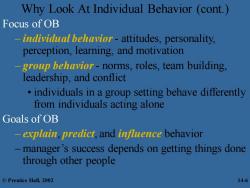
Why Look At Individual Behavior (cont. Focus of OB individal behavior-attitudes,personality, -i perception,learning,and motivation group belavior-norms,roles,team building, leadership,and conflict individuals in a group setting behave differently from individuals acting alone Goals of OB explain,predict,and influence behavior manager's success depends on getting things done through other people ©Prentice Hall,2002 14-6
Why Look At Individual Behavior (cont.) Focus of OB – individual behavior - attitudes, personality, perception, learning, and motivation – group behavior - norms, roles, team building, leadership, and conflict • individuals in a group setting behave differently from individuals acting alone Goals of OB – explain, predict, and influence behavior – manager’s success depends on getting things done through other people © Prentice Hall, 2002 14-6
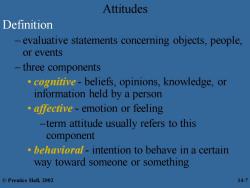
Attitudes Definition -evaluative statements concerning objects,people or events three components cogitive-beliefs,opinions,knowledge,or information held by a person ective-emotion or feeling -term attitude usually refers to this component belbavioral-intention to behave in a certain way toward someone or something ©Prentice Hall,2002 14-7
Attitudes Definition – evaluative statements concerning objects, people, or events – three components • cognitive - beliefs, opinions, knowledge, or information held by a person • affective - emotion or feeling –term attitude usually refers to this component • behavioral - intention to behave in a certain way toward someone or something © Prentice Hall, 2002 14-7
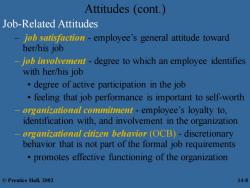
Attitudes (cont. Job-Related Attitudes job saisaction-employee's general attitude toward her/his job -job involverent -degree to which an employee identifies with her/his job degree of active participation in the job feeling that job performance is important to self-worth -organizational commitment -employee's loyalty to, identification with,and involvement in the organization organizational citizen behavior (OCB)-discretionary behavior that is not part of the formal job requirements promotes effective functioning of the organization ©Prentice Hall,2002 14-8
Attitudes (cont.) Job-Related Attitudes – job satisfaction - employee’s general attitude toward her/his job – job involvement - degree to which an employee identifies with her/his job • degree of active participation in the job • feeling that job performance is important to self-worth – organizational commitment - employee’s loyalty to, identification with, and involvement in the organization – organizational citizen behavior (OCB) - discretionary behavior that is not part of the formal job requirements • promotes effective functioning of the organization © Prentice Hall, 2002 14-8
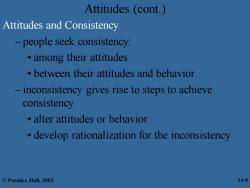
Attitudes (cont. Attitudes and Consistency people seek consistency: among their attitudes between their attitudes and behavior inconsistency gives rise to steps to achieve consistency alter attitudes or behavior develop rationalization for the inconsistency ©Prentice Hall,2002 14-9
Attitudes (cont.) Attitudes and Consistency – people seek consistency: • among their attitudes • between their attitudes and behavior – inconsistency gives rise to steps to achieve consistency • alter attitudes or behavior • develop rationalization for the inconsistency © Prentice Hall, 2002 14-9
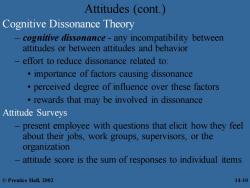
Attitudes (cont. Cognitive Dissonance Theory cognitive dissonance-any incompatibility between attitudes or between attitudes and behavior effort to reduce dissonance related to: importance of factors causing dissonance perceived degree of influence over these factors rewards that may be involved in dissonance Attitude Surveys -present employee with questions that elicit how they feel about their jobs,work groups,supervisors,or the organization attitude score is the sum of responses to individual items ©Prentice Hall,2002 14-10
Cognitive Dissonance Theory – cognitive dissonance - any incompatibility between attitudes or between attitudes and behavior – effort to reduce dissonance related to: • importance of factors causing dissonance • perceived degree of influence over these factors • rewards that may be involved in dissonance Attitude Surveys – present employee with questions that elicit how they feel about their jobs, work groups, supervisors, or the organization – attitude score is the sum of responses to individual items Attitudes (cont.) © Prentice Hall, 2002 14-10
按次数下载不扣除下载券;
注册用户24小时内重复下载只扣除一次;
顺序:VIP每日次数-->可用次数-->下载券;
- 《管理学》课程PPT教学课件(Management, 7th Edition)Chapter 13 MANAGING CHANGE AND INNOVATION.ppt
- 《管理学》课程PPT教学课件(Management, 7th Edition)Chapter 12 HUMAN RESOURCE MANAGEMENT(HRM).ppt
- 《管理学》课程PPT教学课件(Management, 7th Edition)Chapter 11 MANAGERIAL COMMUNICATION AND INFORMATION TECHNOLOGY.ppt
- 《管理学》课程PPT教学课件(Management, 7th Edition)Chapter 10 ORGANIZATIONAL STRUCTURE AND DESIGN.ppt
- 《管理学》课程PPT教学课件(Management, 7th Edition)Chapter 09 PLANNING TOOLS AND TECHNIQUES.ppt
- 《管理学》课程PPT教学课件(Management, 7th Edition)Chapter 08 STRATEGIC MANAGEMENT.ppt
- 《管理学》课程PPT教学课件(Management, 7th Edition)Chapter 07 FOUNDATIONS OF PLANNING.ppt
- 《管理学》课程PPT教学课件(Management, 7th Edition)Chapter 06 DECISION MAKING:THE ESSENCE OF THE MANAGER’S JOB.ppt
- 《管理学》课程教学资源(课件讲义)Stephen P.Robbins(9)Chapter 2 Management Yesterday and Today.pdf
- 《管理学》课程教学资源(课件讲义)Stephen P.Robbins(9)Chapter 1 Introduction to Management and Organizations.pdf
- 《管理学》课程教学资源(教师手册)Stephen P.Robbins(9)CHAPTER TWO Management Yesterday.pdf
- 《管理学》课程教学资源(教师手册)Stephen P.Robbins(9)CHAPTER ONE Introduction to Management.pdf
- 《管理学》课程PPT教学课件(Management)Stephen P.Robbins(9)第十二章 人力资源管理 Human Resource Management.ppt
- 《管理学》课程PPT教学课件(Management)Stephen P.Robbins(9)第十章 组织结构与设计 Organizational Structure and Design.ppt
- 《管理学》课程PPT教学课件(Management)Stephen P.Robbins(9)第十五章 理解群体与团队 Understanding Groups and Teams.ppt
- 《管理学》课程PPT教学课件(Management)Stephen P.Robbins(9)第十九章 运营及价值链管理 Operations and Value Chain Management.ppt
- 《管理学》课程PPT教学课件(Management)Stephen P.Robbins(9)第三章 组织文化与环境——约束力量 Organizational Culture and Environment - The Constraints.ppt
- 《管理学》课程PPT教学课件(Management)Stephen P.Robbins(9)第二章 管理的昨天和今天 Management Yesterday and Today.ppt
- 《管理学》课程PPT教学课件(Management)Stephen P.Robbins(9)第五章 社会责任与道德管理 Social Responsibility and Managerial Ethics.ppt
- 《管理学》课程PPT教学课件(Management)Stephen P.Robbins(9)第四章 全球环境中的管理 Managing in a Global Environment.ppt
- 《管理学》课程PPT教学课件(Management, 7th Edition)Chapter 15 UNDERSTANDING GROUPS AND TEAMS.ppt
- 《管理学》课程PPT教学课件(Management, 7th Edition)Chapter 16 MOTIVATING EMPLOYEES.ppt
- 《管理学》课程PPT教学课件(Management, 7th Edition)Chapter 18 FOUNDATIONS OF CONTROL.ppt
- 《管理学》课程PPT教学课件(Management, 7th Edition)Chapter 19 OPERATIONS AND VALUE CHAIN MANAGEMENT.ppt
- 《管理学》课程PPT教学课件(Management, 7th Edition)Chapter 20 CONTROLLING FOR ORGANIZATIONAL PERFORMANCE.ppt
- 《管理学》课程教学资源(实验讲义)企业竞争模拟攻略篇.pdf
- 《管理学》课程教学资源(习题与答案)第1章 管理活动与管理理论.doc
- 《管理学》课程教学资源(习题与答案)第3章 全球化与管理.doc
- 《管理学》课程教学资源(习题与答案)第6章 计划与计划工作.doc
- 《管理学》课程教学资源(习题与答案)第十章 组织变革与组织文化.doc
- 《管理学》课程教学资源(习题与答案)第16章 管理的创新职能.doc
- 《管理学》课程教学资源(习题与答案)第1章 管理活动与管理理论.doc
- 《管理学》课程教学资源(习题与答案)第3章 全球化与管理.doc
- 《管理学》课程教学资源(习题与答案)第4章 信息与信息化管理.doc
- 《管理学》课程教学资源(习题与答案)第5章 决策与决策方法.doc
- 《管理学》课程教学资源(习题与答案)第6章 计划与计划工作.doc
- 《管理学》课程教学资源(习题与答案)第7章 战略性计划与战略实施.doc
- 《管理学》课程教学资源(习题与答案)第8章 组织设计.doc
- 《管理学》课程教学资源(习题与答案)第9章 人力资源管理.doc
- 《管理学》课程教学资源(习题与答案)第10章 组织变革与组织文化.doc
